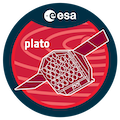Speaker
Description
Ultra-hot Jupiters (UHJs) orbiting pulsating A/F stars represent an important subset of the exoplanetary demographic, as they are excellent candidates for the study of exoplanetary atmospheres, as well as being astrophysical laboratories for the investigation of planet-to-star interactions. Hereafter we show three examples how we separate the stellar variability from planetary phase curves in two systems containing pulsating host star (WASP-169, KELT-9) and for comparison purposes, one system with non-pulsating host star (WASP-186). We present our methodology based on the wavelet-technique. We study the TESS light curves of two planetary systems with A-type host stars (KELT-9, WASP-167) and one system with F-type host star (WASP-186). We developed a new ellipsoidal variability model to take non-synchronous stellar rotation into account. We model simultaneously the ellipsoidal, Doppler beaming and reflection effect to obtain constraints on the geometric albedo and the planetary intrinsic luminosity, while placing a special emphasis on noise separation. A basic model was implement to determine the dayside, nightside and intrinsic temperatures of the planets. That allowed us to give limits for the heat redistribution factor and the Bond-albedo. Transit parameters of the planet seen in previous studies are confirmed. We find that a resonant ∼1/2P stellar signal (which may originate from planet-to-star tidal interactions) interferes with the phase curve analysis in case of WASP-167. For WASP-167b, after considerate treatment of this signal, we find Mp=0.34±0.22 MJup. We measure a dayside temperature of 2790±100 K, classifying WASP-167b as an Ultra-Hot Jupiter (UHJ). We find a 2sigma upper limit of 0.51 on its Bond albedo, and determine the geometric albedo at 0.34±0.11 (1sigma uncertainty). With an occultation depth of 106.8±27.3 ppm in the TESS passband, the UHJ WASP-167b will be an excellent target for atmospheric studies, especially those at thermal wavelength ranges, where the stellar pulsations are expected to be be less influential. We also present the TESS phase curve of the massive (∼16±4.2 MJ ) eccentric (e ∼ 0.33) ultra-hot Jupiter (P ∼ 5 days) WASP-186b. We detect for the first time the occultation of the planet (secondary eclipse) as well as the phase curve parameters via a joint light curve – radial velocity modelling. We derive an occultation depth of 190 ± 51 ppm at p = 0.001 significance level. We provide a 1σ upper limit on the Bond albedo (0.30), a 1σ lower limit on the heat redistribution efficiency (0.84), and measure an intrinsic temperature of 2766±131 K (corresponding to ∼ 7·10−4 L⊙). We use the latter to estimate the tidal dissipation of WASP-186b at Q_P = 107(+118,−107), a value similar to Saturn. We also estimate26 T_day = 2852 ± 114 K and T_night = 2771 ± 130 K. Finally, we also studied the TESS light curve of KELT-9 with the same method. Updated planet parameters are given. We found that the planet dayside temperature is 4798 ± 80 K while its nightside temperature is 2767 ± 241 K. We were able to constrain the intrinsic heat of the planet which corresponds to an effective temperature of 2394 ± 817 K. This intrinsic heat is not originating from the absorbed part of the incoming flux of ohmic dissipation theory nor from the heat produced by gravitational contraction and it is unlikely that it is the residual heat of the formation. However, this amount of intrinsic heat is in perfect agreement with the predictions of the obliquity tide-theorem for the tidally produced heat if we assume that the planetary Q/k2 ratio is strictly between 4 · 10^5...4 · 10^6. We also found the upper limit for Bond-albedo AB < 0.23 and the lower limit for the heat redistribution factor f > 0.88. We put these results into context via studing how the dayside, nightside temperatures of the planets depend on the equlibrium temperature of the planets, and also how the star-planet distance influences the heat-production of exoplanets via obliquity tides.

